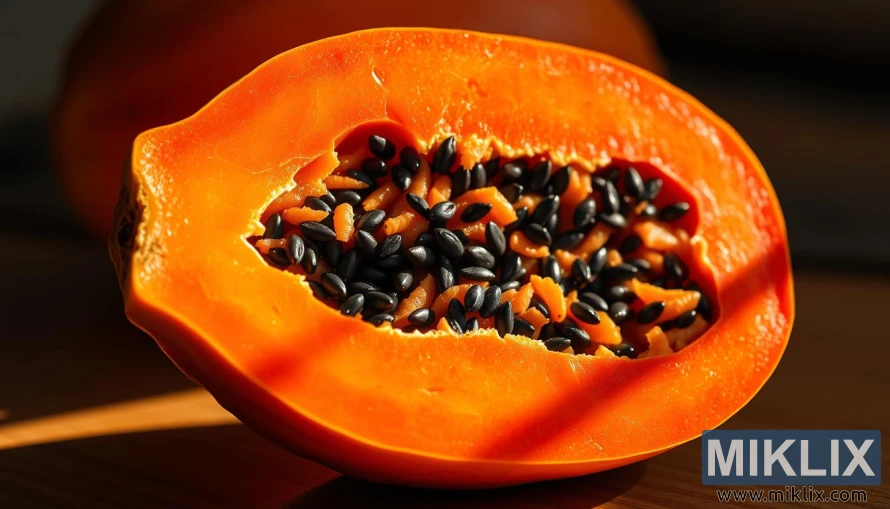Image: Papaya cross-section close-up
Published: May 21, 2025 at 10:06:11 AM UTC
Last updated: September 25, 2025 at 9:02:11 PM UTC
Close-up of ripe papaya cross-section with antioxidant-rich orange flesh and black seeds, softly lit to highlight texture, nutrition, and health benefits.
The photograph presents a strikingly intimate view of a ripe papaya, sliced open to reveal the brilliant vibrancy of its orange flesh and the striking contrast of its glossy black seeds. The fruit seems to glow under the embrace of warm, natural light, each curve and texture amplified by the subtle play of highlights and shadows. The papaya’s flesh appears smooth and luscious, with fine fibrous details catching the light, suggesting both tenderness and juiciness. At the heart of the fruit lies its seed cavity, a dramatic centerpiece filled with dozens of seeds that glisten like polished stones, their deep black sheen punctuated by delicate specks of golden-orange pulp that cling to them. Together, these elements create a scene that is both visually dynamic and sensually inviting, drawing the eye into the fruit’s inner world where color, texture, and vitality converge.
The shallow depth of field sharpens attention on the papaya itself while softening the surrounding environment into a muted blur. This compositional choice heightens the immediacy of the fruit, pulling the viewer into its details—the way the seeds nestle against one another, the gentle indentation of the cavity’s surface, and the richness of the orange tones that shift subtly from deeper red-orange near the edges to golden brightness toward the center. The blurred background serves as a quiet stage, offering no distractions, so the papaya’s inner brilliance and natural geometry can dominate the viewer’s gaze. The light, filtering in at just the right angle, adds warmth and depth, giving the papaya a lifelike presence that almost transcends the two-dimensional plane of the image.
Beyond its aesthetic allure, the image radiates associations with health, nourishment, and tropical abundance. The orange flesh of papaya is widely known to be rich in antioxidants like beta-carotene and vitamin C, compounds that help protect and rejuvenate the body. The black seeds, though often discarded, are themselves carriers of beneficial enzymes and micronutrients, long used in traditional medicine for their digestive and detoxifying properties. The visual contrast between flesh and seeds can be read as symbolic of this duality: sweetness and vitality housed alongside potency and healing. It is as though the photograph is quietly inviting viewers not only to admire the fruit’s beauty but also to consider the wealth of wellness locked within its vibrant form.
The mood conveyed by the image is one of both scientific curiosity and sensual appreciation. The intricate arrangement of seeds, each uniquely shaped and positioned, mirrors natural patterns that scientists and nutritionists alike might study for clues about the fruit’s evolutionary adaptations. At the same time, the luscious glow of the pulp awakens more primal associations—the anticipation of taste, the refreshing burst of juice, the aroma that fills the air when a ripe papaya is cut open. These overlapping interpretations give the photograph a layered richness, speaking equally to the intellect and the senses. It balances analytical intrigue with visceral appeal, making the papaya not just a subject of nutrition but also a celebration of nature’s artistry.
Altogether, the image transcends the simplicity of a sliced fruit to become a visual ode to tropical vitality. The papaya is framed not merely as a food item but as a radiant emblem of abundance, its vivid hues and glistening textures carrying within them the story of sun, soil, and growth. It embodies the essence of balance: beauty and nourishment, indulgence and health, simplicity and complexity. In capturing the fruit with such clarity and reverence, the photograph reminds us that within the everyday act of cutting open a papaya lies an extraordinary convergence of science, sustenance, and sensory pleasure.
The image is related to: From Digestion to Detox: The Healing Magic of Papaya

